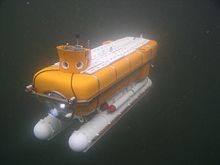Mermaid (submarine)
Under the name Mermaid ( Engl. : Mermaid ) developed and produced the Karlsruhe company Bruker marine technology from 1969 different types of research submarines . The Mermaid I , launched in 1971, is the second deep-sea submarine to be manufactured in Germany after the Tours 64 / DGK 300 type from the Lübeck engineering office .
A total of five types of the Mermaid series were built, another two were planned. Users included P&O and other companies, and areas of application were research and observation in the offshore industry.
Mermaid I.
Construction of the Mermaid I type began in 1969 and construction was completed in 1971. From July 1971 the boat was first tested in a quarry pond near Karlsruhe; further tests took place in 1972 in the Mediterranean near Malta and Sardinia . During the test drives, various uses of a scientific and economic nature were examined.
Technically, Mermaid I formed the basis for further developments in the series. The basic construction principle consists of a cylindrical hull with the pressure hull , in the front area of which there is a tower with the access hatch, a maneuvering propeller and windows in all directions as well as a porthole in the bow and diagonally pointing downwards . The end of the fuselage contains another maneuvering propeller and the propeller nozzle driven by an electric motor as the main drive. Characteristic of the design are the two containers for the lead-acid batteries , which are attached like runners under the hull .
Even with the first model in the series, the hull and pressure hull were manufactured in a sectional construction. The sections are always arranged in the same cross-section and each have a width of 1.7 m with a pressure hull diameter of 1.2 m.
At Mermaid I , the pressure hull was made of steel and took a length of 4.3 m of the 5.2 m long hull. The boat weighed 6.3 t and could dive a maximum of 600 m. It was powered by a 2.2 kW motor, which allowed a top speed of 2 knots . The crew consisted of a pilot and an observer, and the life support systems could work for 60 hours. There was no scientific equipment on board as standard, but the boat was equipped with searchlights and an underwater telephone.
Mermaid II
Mermaid I was converted to Mermaid II in 1974 . The modifications mainly concerned the drive system, the tower cladding, a new bow window and the technical equipment. The new machine system has an output of 3.7 kW and thus enables a maximum travel of 3.2 kn. Due to the new porthole in the bow, the diameter of which has been increased from 22 cm to 76 cm, the hydrostatic load-bearing capacity of the pressure hull is reduced, so that the maximum diving depth was now 540 m. An echo sounder and a swiveling camera were installed as additional equipment .
Testing of the type began in the summer of 1974; in February of the following year the boat was handed over to its new operator, the International Underwater Contractors in New York . One of the most striking uses of this boat was diving trips to the wreck of the passenger ship Andrea Doria , which sank in 1956 . The boat was also used to inspect underwater cables and offshore facilities.
Mermaid III
The development of the Mermaid III began in 1972, but it is actually only the second ship in the series. In contrast to its predecessor, the model has a 1.2 m longer hull, which also contains two pressure hulls connected to one another, which together measure 6.3 m. The rear pressure hull is designed as a chamber for a maximum of two divers; in it there is a downward facing diving lock . Further innovations are the rear propeller, which can be swiveled horizontally by 180 °, and the dome-shaped front window made of acrylic glass .
The significantly larger boat weighs 12.5 t and can dive a maximum of 470 m deep. The electric motor has an output of 4.7 kW and enables a top speed of 2.7 knots. The crew increases to four people through the diving chamber; the life support systems work for 120 hours. Across from Mermaid II , another outdoor spotlight, another camera and equipment for working on submarine cables were installed.
Like the Mermaid II , the boat was launched in the summer of 1974 and was initially tested in inland lakes. In 1975 the boat was sold to the British P & O Subsea Ltd. sold and initially tested off Scotland. It was used primarily for work in the field of offshore oil production in the North Sea.
Mermaid IV
Mermaid IV is essentially identical to the design of the Mermaid III and was built in 1976. The most important innovation is the installation of two gripping arms , which are attached on both sides below the front window. The boat was also provided with extendable legs.
Just like its predecessor, the Mermaid IV was sold to P & O Subsea Ltd. sold, the price is 1.2 million German marks have amounted. The delivery takes place in December 1976.
Mermaid V, VI, VII
The other models in the series, several of which were built each, are all based on Mermaid III and IV . Experience from the construction of the Mermaid series flowed into the construction of the Seahorse series from the 1980s onwards , which in turn produced various civil and military types.
literature
- N. Gierschner: Submersible boats , transpress / VEB publishing house for traffic, Berlin 1980
